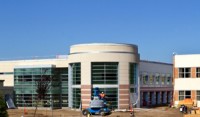Huge VA project to boost med school mission

A new $54 million mental health center is part of a $1-billion-plus renewal project under way at the Veterans Affairs Palo Alto Health Care System and its flagship campus on Miranda Avenue.
BY JONATHAN RABINOVITZ
A dozen state-of the-art buildings that will advance the medical school’s clinical, educational and research missions are beginning to rise, but Stanford isn’t leading the effort.
With a construction budget of more than $1 billion, the Veterans Affairs Palo Alto Health Care System, or VAPAHCS, has launched an ambitious building project on its flagship campus on Miranda Avenue in Palo Alto, leaving almost no spot of the 93-acre site untouched. The plan includes a new mental health center; the Department of Veterans Affairs’ largest rehabilitation center, which will combine polytrauma and blind rehabilitation; additional research space; and additional lodging facilities for veteran patients and family members.
The project is driven by an emphasis on patient-centric care and concerns about seismic safety. The project is also part of a broader shift by the VA and health care in general toward more outpatient services, concentrating the most advanced tertiary care services at flagship facilities, such as the Palo Alto site. VAPAHCS, in addition to revamping and expanding its outpatient facilities outside the Palo Alto campus, is taking steps to ensure that its main campus continues to offer the latest treatment modalities and meet new and pressing needs, such as those of the increasing numbers of veterans who have suffered multiple injuries, including traumatic brain injury. As part of that process, VAPAHCS is enhancing its 50-year affiliation with the School of Medicine, adding space for the education of Stanford doctors who treat veterans and the research by Stanford faculty on injuries and illness that affect veterans and others.
“Our success is predicated in part on the success of Stanford medical school,” said Jason Nietupski, the VAPAHCS director of planning and development. “The more successful Stanford is, the more successful our programs are.”
VAPAHCS spans a 10-county, 13,500-square mile region encompassing 275,000 veterans. It had research expenditures of approximately $75 million in 2010, the second- largest research program in the national VA network, supporting 200 principal investigators, including about 90 faculty members from the medical school. This year, VAPAHCS is training 750 residents and fellows and 211 medical students from the School of Medicine. It has more Centers of Excellence — programs with special emphasis — than any other VA health-care system nationwide, and thousands of veterans are referred each year from outside its catchment area to benefit from the expertise, and specialized services it offers.
The first new building in the project, a $54 million, 80-bed mental health center, is slated to be completed by the end of 2011. In an effort to achieve a therapeutic design and supportive environment, natural lighting is used to aid in the healing process with direct access to landscaped gardens, recreation and exercise areas, and a separate research and office pavilion. All of the inpatient units are on the first floor for more efficient service.
“There is little comparison between this facility and existing VA mental health facilities,” said Jerome Yesavage, MD, a professor of psychiatry and behavioral sciences who is the associate chief of staff for mental health at VAPAHCS. “The building will be a model for the VA nationally.”
Yesavage, who is also the director of the Mental Illness Research Education and Clinical Center at VAPAHCS, said there would now be room for many specialists currently at the VA site in Menlo Park (which is part of VAPAHCS) to relocate to Palo Alto. “The new building will be a focus of mental health education,” he said, noting that it also has classrooms as well as space for a telemedicine training program for residents. “While the VAPAHCS is a national leader in care through telemedicine, such training is not available at Stanford.”
In addition, the new building will make it easier for mental health professionals to treat the growing number of veterans who have suffered severe injuries to more than one organ system and often have post-traumatic stress disorder and other mental health issues. Members of the mental health staff will eventually be able to walk next door to the Polytrauma and Blind Rehabilitation Center, for which a $98.8 million construction contract was awarded Sept. 30.
The Palo Alto campus is one of five facilities in the country designated by the VA to provide intensive rehabilitative care to veterans and service members who have multiple traumas. At 174,000 square feet, the new building will be the largest rehabilitation center in the federal government, with 24 beds for polytrauma/physical medicine and rehabilitation, or PM&R, patients; 32 beds for the blind rehabilitation program; and 12 beds for the polytrauma transitional program, which teaches disabled veterans such daily activities as driving and cooking. The new facility will co-locate inpatient and outpatient rehabilitation programs including PM&R, physical therapy, occupational therapy, and polytrauma and blind rehabilitation within a single state-of-the-art treatment center.
This new rehabilitation center will consolidate providers of polytrauma and vision rehabilitation, who are now distributed around the Palo Alto campus into the same facility.
“The entire system of care for polytrauma and vision-loss patients will be in one building, and that in itself will augment the care we provide,” said Odette Harris, MD, an associate professor of neurosurgery and the VAPAHCS associate chief of staff for polytrauma, who is also director of the Palo Alto site of the Department of Defense-supported Defense and Veterans Brain Injury Center. “This initiative will also provide improved therapy spaces and will be tailored to our polytrauma population — a population that didn’t exist at the time many of our current facilities were built.” The current polytrauma center is housed in a building constructed in 1960.
When completed in 2014, the building will also impact the Stanford trainees in the physical medicine and rehabilitation residency, who provide care for the polytrauma patients. “It’s a top-notch residency, and this building will only make it better,” said Harris.
The benefits for Stanford researchers go beyond polytrauma to other research areas, including stem cells, genomics and bioengineering. While such work already occurs at VAPAHCS, the plans include relocating some of these activities and providing even more space. Construction of a $127 million basic science research center and vivarium is set to begin in 2013 and to be completed in two years. At 143,000 square feet, the new building will create additional wet labs, in an open configuration, providing more flexibility and capacity for research interaction between laboratory groups. A 31,500-square-foot vivarium in the basement level of the new facility will provide investigators with easy access to lab animals.
“The new vivarium will be even larger and more modern than the one we have now, which will foster the ever-expanding animal research here,” said Thomas Rando, MD, PhD, professor of neurology and neurological sciences and director of the Center for Regeneration, Repair and Restoration at VAPAHCS.
Rando added that having more researchers located together would spark creativity. “This will enhance interactions among investigators; geography is critical,” he said. What’s more, the new building will provide researchers with access to more and enhanced core facilities, a variety of expensive advanced lab technologies that researchers typically share and that require experts to operate.
“All of this will help us to recruit new investigators,” added Rando. “We’re quite full right now, and this will open up new space. This is good not only for the VA but also for Stanford.” Indeed, it may help Stanford faculty already at the VA to increase their lab space, as well as potentially opening up space for new jointly appointed Stanford/VA investigators.
Substantial space will be devoted to regenerative medicine, particularly stem cells, in a way that will complement the work going on at the medical school. “Here it’s even more focused on translational work, especially for chronic disease and chronic injuries relating to combat,” Rando said. “There’s a very active dialogue between the two programs.”
VAPAHCS is also launching a genomics initiative in collaboration with the Stanford departments of Genetics and of Biostatistics to establish an informatics center to link whole genome sequencing data with the VA’s comprehensive electronic medical record.
In addition VAPAHCS is planning to build a 327,000-square-foot, six-story ambulatory care facility with clinics for primary care, specialty care, women’s health, dental care, eye care, ENT, prosthetics, audiology and speech pathology. With the transition toward outpatient care it has also made a concerted effort to expand its services for women veterans.
“It’s not really one project — it’s multiple integrated projects,” said Nietupski. “Almost the entire campus will be touched.”
